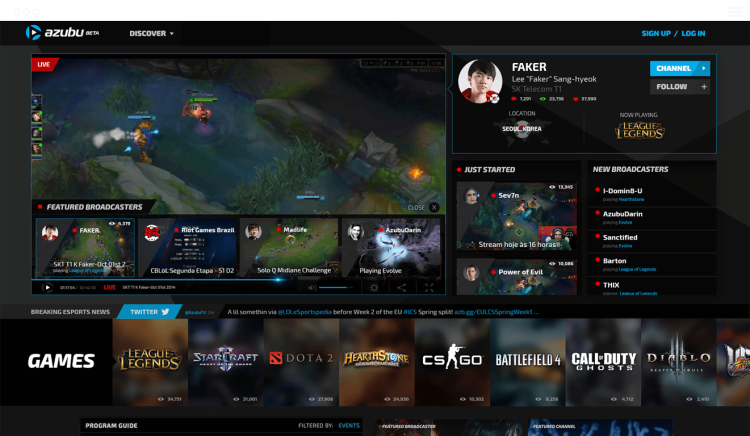This sponsored post is produced in association with Azubu.
Esports is knocking it out of the park.
Okay, excuse our interathletic idiom, but the fact is competitive video gaming has become hugely popular — and promises to be even more lucrative for many of its participants in the coming years. It’s growing so quickly, in fact, that there’s wide-ranging debate about how big it can become and if we’ll see it peak anytime in the near future.
For example, a little more than a month ago, industry intelligence firm NewZoo released its “Global Growth of eSports Report” with a forecast that eSports will bring in annual revenues of $765 million by 2018 from an audience of more than 165 million enthusiasts. NewZoo estimates that $337 million of that will be revenue from online advertising.
Meanwhile, in early October, Colin Sebastian, managing director and senior equity research analyst with R.W. Baird, predicted in a research report that he believes eSports will generate more than $1.8 billion in annual revenue by 2020.
“We believe that eSports is on the cusp of reaching mainstream adoption,” Sebastian said in the report, “including 200 million active and engaged participants as early as next year.” He added that “game publishers [are] committing significant resources to build eSports infrastructure,” and noted that there’s been approximately $175 million worth of venture funding pumped into eSports companies in the past 18 months. All that for a media segment Sebastian calls “relatively unknown outside video game circles.”
Indeed, eSports has seen incredible growth and, as NewZoo and Sebastian have noted, will tilt the growth line at a steeper upward angle over the next decade. Jason Katz, COO at eSports streaming network Azubu, points to some strong cause-and-effect as to why eSports will continue to be such a powerful, sustainable segment of the game industry.
“One of the most important developments that will ensure the continued growth of eSports is the structural involvement of the publishers,” Katz says. “Until fairly recently, game publishers were somewhat indifferent to eSports because of their business model — selling discs of physical media and coming out with new games every year for what they hoped would be an expanding mainstream consumer base.
“But with the success of free-to-play games monetized with microtransactions,” Katz continues, “there is a renewed focus on hard-core gamers, who are heavily engaged in the games and have a propensity to spend over time on microtransactions. These core customers are disproportionately interested in watching and participating in eSports. So now we see the big publishers — Riot, Valve, Activision, Blizzard and others — embracing eSports as a core aspect of game development.”
This publisher involvement is driving a significant portion of the upswing in funding and professionalism in eSports. In fact, we’re seeing a lot of direct organizational support coming from these companies. As examples, Katz points to Riot’s establishment and coordination of worldwide, professional League of Legends leagues; and The International, an annual Dota 2 tournament organized by Valve (the game’s developer/publisher), which sported a record crowdfunded prize pool of more than $18 million in its fifth installment, which concluded this past August.
The massive growth of lucrative events and tournaments is, in turn, bringing about a welcome change for the pro players, who used to have to hold jobs to support themselves, which cut into critical practice and gameplay time, or be forced to “retire” from eSports when they emerged from school. Now, salaries, rich prize pools, streaming fees and sponsorship deals enable the best players to concentrate full time on honing their competitive-gaming craft, much like professional athletes and other major entertainment stars.
“Historically, players’ pro careers were short because very few of them could support themselves for any meaningful length of time,” Katz says. “There was a high level of turnover, which reduced the ability for fans and players to develop a long-term relationship. That is a critical element to providing long-term growth for any sport — and it didn’t exist until recently for eSports. Now more players can support themselves with eSports alone, which is allowing true professionalism to develop for eSports competitors.”
The structural growth that Katz talks about is a foundation that also now supports the existence of managers, coaches, agents, and lawyers to help coordinate the business side; numerous media sources to cover the action that’s regularly taking place around the globe; and even the parallel growth in eSports fantasy leagues and betting sites, all of which speaks to eSports’ rapidly-growing popularity. After all, when cable networks such as ESPN start integrating coverage of eSports events and news into its schedule, you know you’ve gone mainstream.
And that’s a grand slam for everyone involved.
Sponsored posts are content that has been produced by a company that is either paying for the post or has a business relationship with VentureBeat, and they’re always clearly marked. The content of news stories produced by our editorial team is never influenced by advertisers or sponsors in any way. For more information, contact sales@venturebeat.com.

